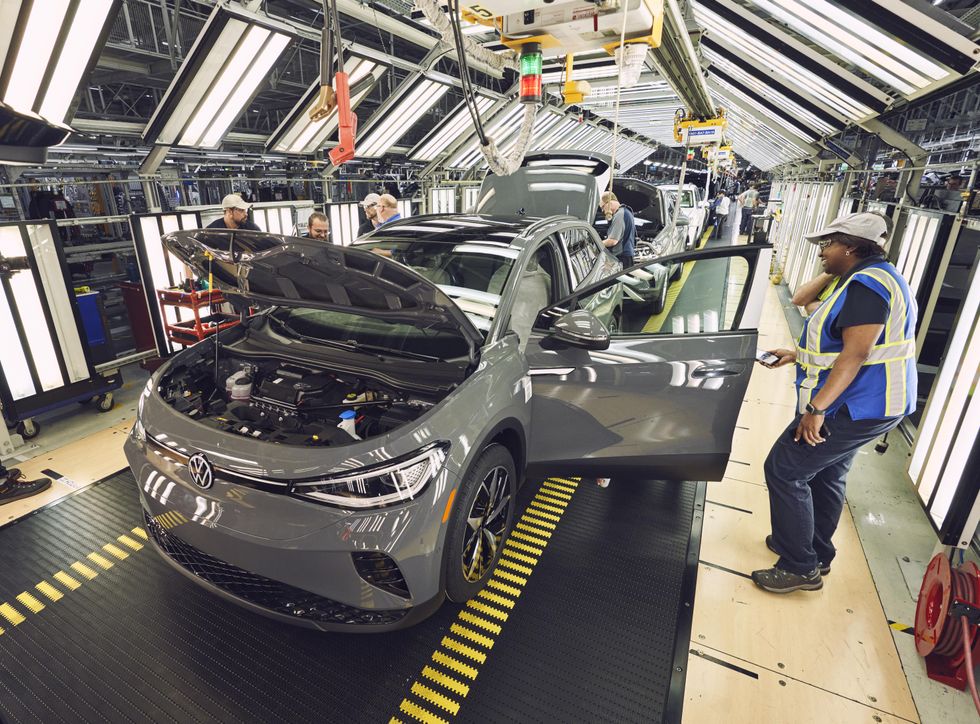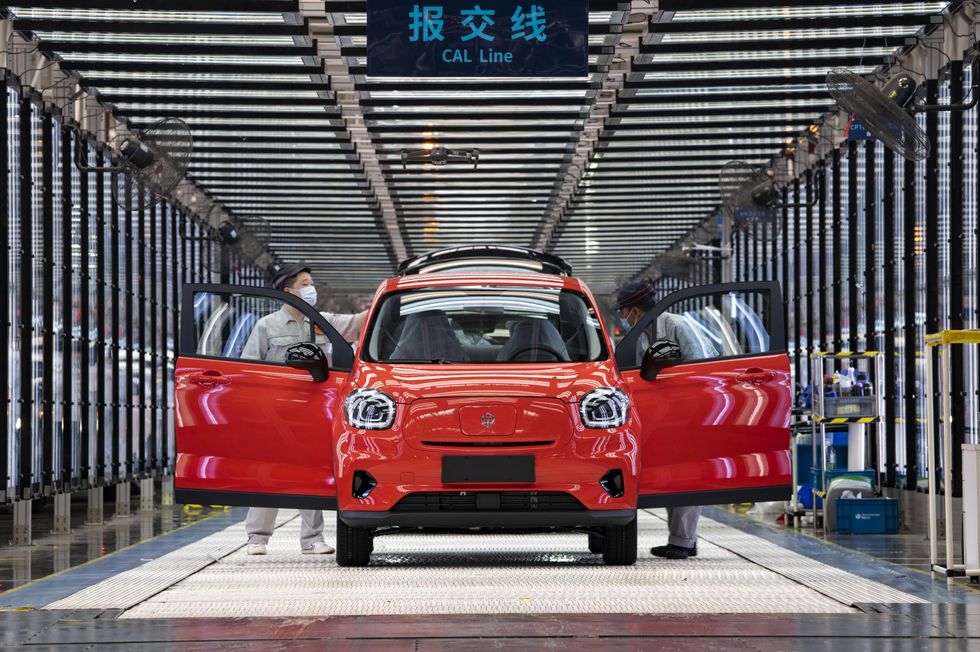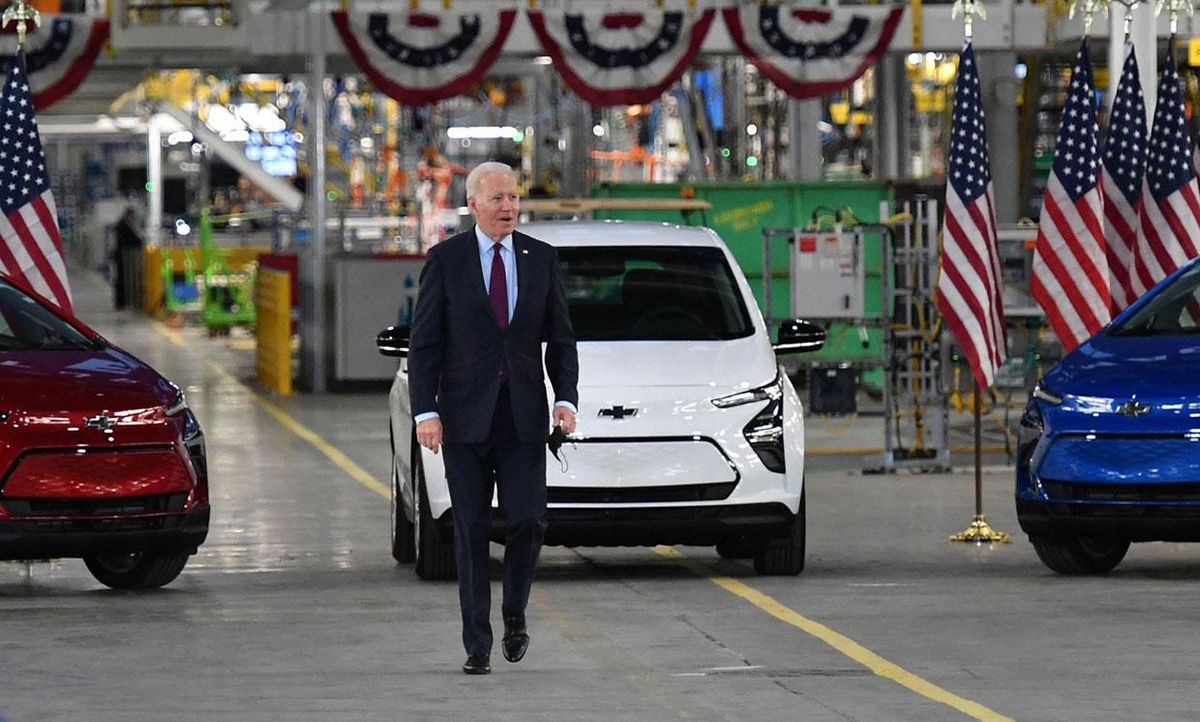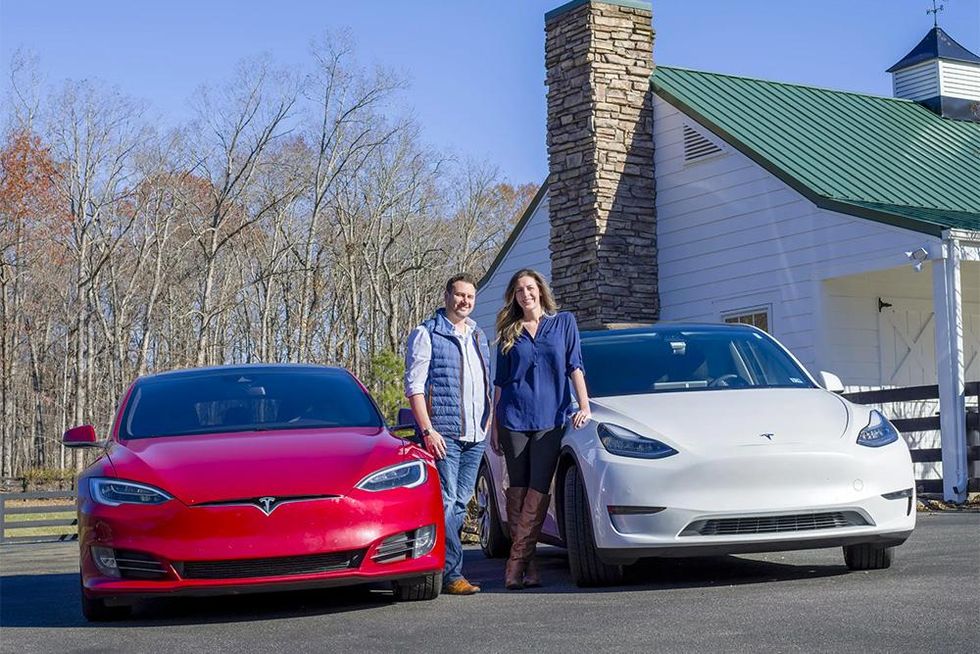The Biden administration is very clear on what it desires to achieve with its environmental policy: a complete transformation of the nation’s US $21 trillion economy away from fossil fuels.
The administration is undertaking multiple actions to place the United States on what it calls an “ irreversible path” to achieve a 50 to 52 percent reduction in greenhouse gas emissions by 2030 from a 2005 baseline, and then to achieve net-zero emissions by 2050. This is to try to meet the Paris Agreement of limiting global warming to 1.5 °C, compared to preindustrial levels. Achieving this transformation will be through what The New York Times describes as “economic nationalism” with electric vehicles( EVs) as the tip of the spear for economic, environmental, and societal change.
The EV Transition Explained
This is one in a series of articles exploring the major technological and social challenges that must be addressed as we move from vehicles with internal-combustion engines to electric vehicles at scale. In reviewing each article, readers should bear in mind Nobel Prize–winning physicist Richard Feynman’s admonition: “For a successful technology, reality must take precedence over public relations, for Nature cannot be fooled.”
Or as put in a recent consultancy Ernst & Young’s position paper, “Market forces alone won’t solve the problem, and the onus is on governments to take a lead.”
This controversial government-directed “top-down driven approach” the administration is pursuing is a major break from the past primarily market-driven “bottom-up approach” for encouraging the transition to EVs. This new approach is not merely an incremental subsystem-level change, like setting new vehicle mileage or emission standards, but a whole system change.
“Who is looking at the full picture of this transformation?” —Carlos Tavares, CEO of Stellantis
As Dave Cooke, senior vehicle analyst at the Union of Concerned Scientists, emphasized at a National Academy EV workshop last year, “This transition isn’t just about emissions. That is perhaps the most important point.” As the clean-energy transition is made, Cooke says, “we’re talking about a massive reshaping of our economy at the same time.”
However, Lee Vinsel, a Virginia Polytechnic Institute technology historian and expert on how regulatory policy has improved auto safety and lowered pollution warns, “Policy reflected in EVs must be crafted to reduce the risks to hundreds of millions of individuals that feel they’re not giving anything up.”
How massive an economic reshaping is in store? There are at least 9 million U.S. workers directly employed across the automotive, energy, and transportation industry sectors, as well as some 20 million other workers dependent upon these industries who are likely to be first affected. Nearly 20 percent of U.S. GDP immediately comes into play in the transition to EVs.
To underscore its intent, the administration has set an aggressive goal of 50 percent of all new vehicles sold in the United States to be EVs by 2030. This objective is more than 20 percent greater than the enthusiastic projected sales of the June 2022 Edison Electric Institute’s analysis. However, the administration has gained commitments from major automakers to help achieve this goal, earmarking $1.2 trillion toward building EV and battery factories worldwide.
The Biden administration has fully embraced the United Auto Workers (UAW) report, “Taking the High Road: Strategies for a Fair EV Future,” which argues that “advanced vehicle technology should be treated as a strategic sector to be protected and built in the U.S.” The UAW report further asserts that “the economic potential of EVs will be lost if their components are imported.” Preventing that outcome, the UAW states, needs a “strong, forward-looking industrial policy” to reap the benefits of fully transitioning to EVs.
EVs as job creators
The administration has openly supported the UAW conclusions and claims that achieving the EV and clean energy objectives it has set out will “position America to win the future of transportation and manufacturing and create good-paying, union jobs, dramatically expand American manufacturing, make electric vehicles more affordable for families, and export our electric vehicles around the world.”
This sets out U.S. government policy objectives not only to decrease greenhouse gases, but to be the global EV industrial leader. Through a series of presidential executive orders and legislation, the administration has bolstered its industrial objectives providing incentives for EV purchases including clean school buses, battery development, mining and recycling, semiconductor manufacturing, expanded opportunities for EV charging, as well as for improving the electrical grid.

Volkswagen’s ID.4 compact all-electric SUV advances down an assembly line in VW’s new factory in Chattanooga, Tenn.
Volkswagen of America, Inc.
The federal government has also increased mileage standards for new passenger cars and light trucks to a fleet average of 49 miles per gallon in model year 2026, up from 41 mpg today. Even more stringent standards are planned for model years 2027 to 2029. The net effect is to force automakers to sell more EVs and fewer internal-combustion-engine (ICE) vehicles to meet the fleet average, an approach the Australian government is using, too.
To date, the Biden administration has committed more than $435 billion over the next decade to support the EV transition, and many billions more is likely. Recently four federal departments and agencies—the departments of Energy, Transportation, Housing and Urban Development and the Environmental Protection Agency—have signed a Memorandum of Understanding to coordinate their activities to further “decarbonize the transportation sector.”
California sets the pace
Individual states have set out their own EV policies as well. California, for instance, which has possessed the right since 1970 to determine its own vehicle-emission standards, has deliberately set out a more aggressive goal than the federal government. With 11 percent of all U.S. new light-duty vehicles sold in the state annually, or around 2 million vehicles, its environmental policies have market clout.
California has mandated that by 2035 only sales of zero-emission new cars and light trucks (ZEVs) will be allowed. Until then, California is aiming for 35 percent ZEV sales by 2026 and 68 percent by 2030. As of the first half of 2022, California ZEV sales reached more than 16 percent. Some 61 percent of all those ZEV sales to date were Teslas.
Where is the clean energy? Where is the charging infrastructure? —Carlos Tavares
California, like nearly every other state, has a wide range of incentives for purchasing EVs and installing chargers. Recently passed legislation would increase to $10 billion the amount the state is committing to EV incentives over the next five years.
Seventeen other states have agreed to follow California auto-emission rules, with 15 indicating they will embrace its ZEV requirements. Together, the 18 states represent some 41 percent new light-duty vehicles sold, worth $486.7 million dollars in new-car sales in 2021, according to data from the National Automobile Dealer Association.
There is some question of how prepared some of these states are to support these ZEV requirements, however. Massachusetts, for example, has set a goal of at least 750,000 to 1 million EVs on the road by 2030; it currently has some 51,000, of which 31,000 are battery electric. The state also wants 15,000 public charging stations by 2025 and 75,000 by 2030; it currently has about 4,600.
The geopolitics of EVs
The United States is far from alone in wanting to use EVs to “win the future of transportation and manufacturing.” The European Union, China, and Japan, as well as the United Kingdom and South Korea all have announced the same intention. Each has set its own environmental policies to push the countries toward transition to EVs at scale. For example, the U.K. will stop the sales of new diesel and petrol-fueled cars and vans from 2030 on. All new vehicles sold will be ZEVs in 2035. The EU has also banned the sale of new diesel and petrol-fueled cars by 2035, while Japan, with 24.5 percent of new car sales being (mostly hybrid) EVs, says all new cars sales in 2035 will be electric.
China is the acknowledged leader in EV production. From mining to EV charging stations and everything in between, China has secured its EV supply chain and infrastructure. Like the United States, the China also expects to become the undisputed global leader in EVs. In 2014, President Xi Jinping defined China’s intent, stating, “Developing new-energy vehicles is the only way for China to move from a big automobile country to a powerful automobile hub.” The Chinese government long ago realized that if ICE vehicles were to be eliminated, China could effectively compete with Western automakers.
 Employees work on the assembly line of T03 electric small crossover at a factory of Chinese EV startup Leapmotor on April 26, 2022 in Jinhua, Zhejiang Province of China.
Hu Xiaofei/VCG/Getty Images
Employees work on the assembly line of T03 electric small crossover at a factory of Chinese EV startup Leapmotor on April 26, 2022 in Jinhua, Zhejiang Province of China.
Hu Xiaofei/VCG/Getty Images
China aims to have 20 percent of new vehicles sold be New Energy Vehicles (NEVs), which include battery electric (BEV), plug-in hybrid electric (PHEV) and fuel-cell electric vehicles (FCEV) by 2025. This percentage will likely be reached this year. The NEV goal goes up to 50 percent by 2030, and 50 percent by 2035, with the other 50 percent being (non-plug-in) hybrids. No conventional ICE vehicles will be sold after 2035. This ban goes into effect even sooner in the Hainan Province, whose government has decreed no fossil-fueled automobiles will be sold after 2030. Other provinces may follow suit.
Where are the raw materials? Where are the geopolitical risks of sourcing those raw materials? —Carlos Tavares
The scale China brings to the EV transition is truly stunning: There are already some 300 companies making EVs there. In September 2022 alone, more than 675,000 NEV passenger cars were sold in China— more than the number sold in the United States in 2021. It exported 500,000 EVs in 2021,as well. Some 5.8 percent of European EVs on the road today are Chinese made, with predictions of 12 percent to 20 percent being Chinese brands by 2030.
The Chinese government has also made known that it will protect the country’s EV leadership position. Chinese Ambassador Qin Gang recently made it very clear at the 2022 Detroit Auto Show that the country would not take kindly to any efforts by the United States or other countries to remove it from the EV supply chain or markets. “To decouple with China means to disconnect from the world’s largest market as well as the biggest opportunity,” Qin Gang stated. He added that “the industry chain has been relatively well established over past years, and there would be no winner if anybody wanted to intervene or even destroy [it].”
Australian Resources Minister Madeleine King tacitly agrees with this sentiment, saying that it was a “pipe dream” that any Western country could end its EV mineral dependence on China. King is quoted in an interview with Bloomberg News as saying that China saw, “this need coming and made the most of it.” Australia, she said, will provide a second source of needed minerals, but is not looking to replace China.
China, along with the EU, Japan, and South Korea, has also voiced unhappiness with the United States’ EV tax-credit incentives that now require certain percentages of EV components be manufactured or assembled in North America. South Korean auto companies Hyundai and Kia are already blaming drops in their U.S. electric vehicle sales to the new law. These countries undoubtedly see the content requirement as a foreign policy shot across the bow. Given the Biden administration’s lukewarm response to the complaints, it would not be surprising for other countries to enact retaliatory policies.
The wide swath of policies supporting EVs across the globe combined with the financial commitments of automakers makes the EV transition seem inevitable. The policies also reflect the tremendous number of industrial activities that need to occur to bring EVs to scale, and governments’ outsize role and risks in making it happen. However, as Virginia Tech’s Vinsel observes, “Policymakers often only weigh the benefits [of their policies], and not their other outcomes.”
As a result, the question of how quickly EV policies must—or can—be implemented has spawned vociferous debates.
According to a report by Reuters, the questions that will fuel those debates were posed by Stellantis CEO Carlos Tavares this past October at the FT Future of the Car 2022 conference in Milan. While delivering remarks on near-term battery supply-chain issues and the substantially increased amount of raw materials required for each new EV as compared with ICE vehicles, Tavares asked, “What’s next? Where is the clean energy? Where is the charging infrastructure? Where are the raw materials? Where are the geopolitical risks of sourcing those raw materials? Who is looking at the full picture of this transformation?”
In the next part of the series on the transition to EVs at scale, we look at what the skeptics of current EV policies have to say.
- Can Alt-Fuel Credits Accelerate EV Adoption? ›
- The EV Transition Explained ›
- The EV Transition Explained: Policy Roadblocks - IEEE Spectrum ›
- Why EVs Aren't a Climate Change Panacea - IEEE Spectrum ›
Robert N. Charette is a Contributing Editor to IEEE Spectrum and an acknowledged international authority on information technology and systems risk management. A self-described “risk ecologist,” he is interested in the intersections of business, political, technological, and societal risks. Charette is an award-winning author of multiple books and numerous articles on the subjects of risk management, project and program management, innovation, and entrepreneurship. A Life Senior Member of the IEEE, Charette was a recipient of the IEEE Computer Society’s Golden Core Award in 2008.





